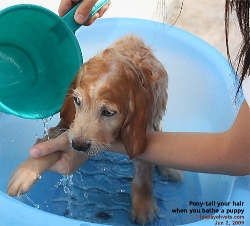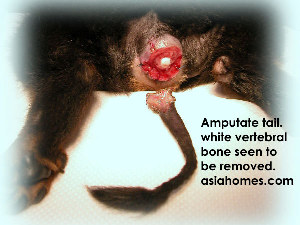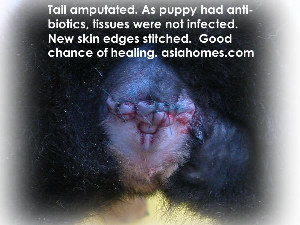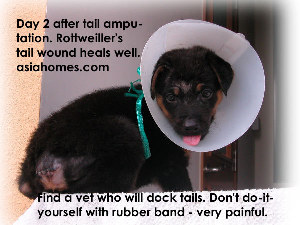|
Case 1.
Do-It-Yourself Tail Docking
Case 2. Tail Amputation Using
Electrosurgery
Dr Sing
Kong Yuen, BVMS (Glasgow), MRCVS
Case written: 28 November 2003
Updated:
26 June, 2009
|
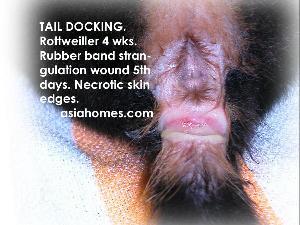 "Is
it possible to amputate the
Rottweiler's tail now?" Mr
Alfonso
asked as he showed me the deep
strangulated wound near the 4-week-old
puppy's anus. The coccygeal muscles
showed through the gap between the
yellowish white skin edges which are
about to become gangrenous. "Is
it possible to amputate the
Rottweiler's tail now?" Mr
Alfonso
asked as he showed me the deep
strangulated wound near the 4-week-old
puppy's anus. The coccygeal muscles
showed through the gap between the
yellowish white skin edges which are
about to become gangrenous.
"How long was the rubber band used?" I
asked. Rubber bands are often
used to dock tails of older puppies to
save money and in many cases, most
vets in Singapore don't want to
perform tail docking. Therefore, the
home-breeder had to resort to
do-it-yourself.
"5 days," Mr Alfonso replied. "My
Rottweiler puppy has been licking this
area for some time."
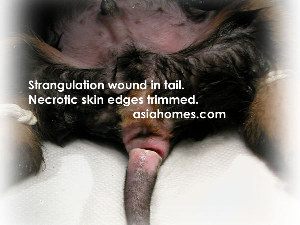 "It
is possible to cut off the tail," I
said. "However, the skin stitches will
not hold together, since the area is
infected by bacteria and is full of
bacteria toxins." Mr
Alfonso
nodded his head. "It
is possible to cut off the tail," I
said. "However, the skin stitches will
not hold together, since the area is
infected by bacteria and is full of
bacteria toxins." Mr
Alfonso
nodded his head.
I continued: "Once the skin
stitches break down, there will no
more healthy skin to stitch. You will
have to bear the responsibility for a
big ugly hole in the tail for the rest
of the dog's life. Will you accept
this risk?"
Mr Alfonso needed time to imagine the
horrible complications.
Surprisingly, the puppy's rectal
temperature was normal at 38.5 degrees
Celsius. I had asked Mr
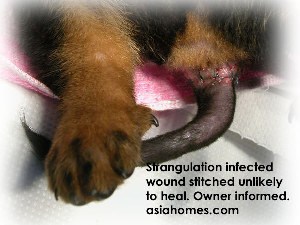 Alfonso
to enter the operating room to see for
himself the necrotic tissues of the
tail so that he would understand that
any skin repair surgery might be
unsuccessful. Alfonso
to enter the operating room to see for
himself the necrotic tissues of the
tail so that he would understand that
any skin repair surgery might be
unsuccessful.
"I can try to stitch up the edges of
the strangulation wound," I
said. "Dying cells are white-yellow in
colour and the skin is melting away.
This area cannot heal properly. Do you
still want the stitching to be done?"
What would be Mr Alfonso's response? He
shook his head. He would not take the
risk of tail amputation now. What was
now the solution to this situation?
One solution was to stitch up the
wound, using new skin edges.
He gave permission for tail skin to be
stitched and a later surgery to dock
the tail further away from the anal
region. U Usually, the tail is docked
at the area where the brown and black
colours of the tail meet. This gives
the Rottweiler some tail length.
At the present level, the Rottweiler
would be tail-less as the rubber band
had been placed too high up, too close
to the anal area. I stitched up new
skin edges as the puppy slept under
general gas anaesthesia, unaware of
the painful tail.

"You've got to pray that the puppy
will not die," Nurse Ann said as she
clasped her hands together and looked
at the ceiling. Nurse Ann was a
devout Catholic.
Puppies do die of infection
subsequently although this one looked
strong on the operating table. Nurse
Ann had seen numerous puppy deaths
over the years. Canine deaths happen
in veterinary premises all over the
world.
I had advised that the puppy be kept
in the surgery for a day or two for
observation. However, Mr and Mrs
Alfonso wanted the puppy home. There
was no need to pray for divine help.
5 days later, the Rottweiler came with
a shrivelled tail. Pus and hairs
plastered the wound and all stitches
had separated. As the puppy had been
on antibiotics, the tissues and
muscles were fresh red. No bacterial
infection. I anaesthesized the puppy
and removed the dying portion of the
tail. A white coccygeal vertebral bone
protruded from the exposed gap. There
was insufficient skin to close this
gap. What should I do?
Any stitching over the tail bone would
definitely result in wound tension.
The stitches would break down and
there would not be a second chance.
Mr Alfonso would not be so happy.
I
had to get new skin further up. I cut
off the protruding bone so that the
new skin edges could cover.
I needed 14 days for the edges to heal
strongly. Would there be infection and
pain? A painful puppy would try
to rub its tail on anything to relieve
the pain and the neck's Elizabeth
collar will be ineffective. The
puppy was not much bothered. It had
fever in the evening and recovered. It
had a good appetite.
I asked his wife to care for the puppy
at home to save further veterinary
costs when she came to visit the puppy
on day 3. Low veterinary costs
are much appreciated by pet owners all
over the world.
The veterinary cost for two general
anaesthesia and surgeries amounted to
around $400. A rubber band tail
docking of an older puppy would not be
costly but the puppy had to endure at
least 10 days of a painful and
infected tail while
the tail dies from deprivation of
blood supply and falls off. Some
puppies may die from infections
arising from the do-it-yourself tail
docking. In this case,
the Rottweiler puppy was alive and
that was most important to Mr Alfonso
and his daughter.
BE KIND
TO PETS:
In 2003/2004, some vets in Singapore
do not dock tails as they consider
this surgery cruel. The animal rights
activists have been asking for tail
docking by veterinarians to be banned.
In the U.K, I believe that a law
prohibits tail docking by any person
other than veterinarians. Another law
prohibits veterinarians from doing
tail docking. From the breeder's
point of view, they have to
do-it-yourself even if they don't want
to! Recently, some Australian states
appear to have banned tail docking and
puppies such as the Doberman, imported to Singapore
have long
tails.
|
Case 2. Tail Amputation Using
Electrosurgery |
|
In older dogs, the strict
attention to prevent tail
rubbing and licking and
prevention of bacterial
infections must be adopted.
Otherwise, there will be a big
hole in the tale and a very
unhappy owner.
Surgical procedure &
post-surgical nursing
Tourniquet
on tail using rubber bands.
Use a marker pen to mark the skin
incision lines.
The horizontal marker line in
the upper part of the tail
should be 1 cm more caudal (longer) than the
lower part of the tail. A
V-incision is cut, starting from
the longer upper edge to
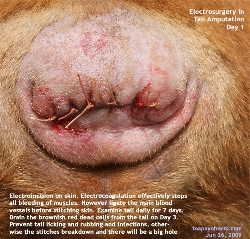 the
shorter lower edge when viewed
laterally from the base of the
tail. the
shorter lower edge when viewed
laterally from the base of the
tail.
Electroincision cuts off the
skin and tail.
The dorsal incision should be 1
cm longer than the ventral
incision so that the upper tail
skin edge curls downwards and
provides an excellent skin
cover. If you incise
perpendicularly, the skin edges
do not heal well and there is a
big ugly hairless bony stump
seen later. Incise the tail bone
at the joint so that there will
not be remnants of tail vertebra
which may become infected. I
used a bone-cutter in this case
to cut at the joint between the
tail vertebra 1 cm cranial to
the top skin edge.
Electrocoagulation sealed all
bleeders around the muscles of
the tail. There was no bleeding
seen. I still ligated the
major blood vessels with your
absorbable sutures. However, by
Day 3, there was accumulation of
"blood". They were dead muscle
cells and bleeding from the
muscles (reddish brown liquid).
These amounted to around 20 ml
and were drained by pressing the
tail stump. I checked the tail
stump daily to ensure that the
nurse had not overlook this
important aspect of nursing.
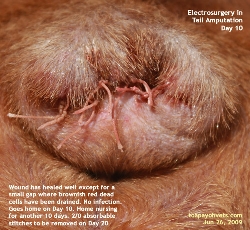 By
Day 5, there was a small hole
due to the drainage of dead
cells. Antibiotic powder was
applied.
Antibiotics and pain-killers
were given. The dog started to
rub his tail on the floor of the
crate. Mild sedation tablets
were given. By Day 10, the dog
was OK to go home for home
nursing and to save on
veterinary costs for the owner. By
Day 5, there was a small hole
due to the drainage of dead
cells. Antibiotic powder was
applied.
Antibiotics and pain-killers
were given. The dog started to
rub his tail on the floor of the
crate. Mild sedation tablets
were given. By Day 10, the dog
was OK to go home for home
nursing and to save on
veterinary costs for the owner.
If the owner wants the dog back
within a day of surgery (to save
on veterinary costs), do not
bother to do the surgery as the
outcome will not be good for the
dog or the vet as the owner
would need to pay for resolution
of a badly infected wound. Most
owners don't know how to take
care of the wound or the dog may
not co-operate at home.
This surgery needs a lot of
post-surgical veterinary nursing attention to prevent
stitch breakdown. Despite pain
killers, the dog will try
to lick the tail. An e-collar
and mild sedation orally prevent
licking but the dog can rub its
tail hard on the surface of the
floor to relieve his itchiness.
Antibiotics are given for around
14 days.
It also needs
the vet to provide strict
supervision of the veterinary
nurses as this category of
surgery is rarely by vets
in Singapore in 2009. Tail
docking is considered cruelty
to healthy dogs and vets
discourage such cosmetic
surgeries.
However, if the tail is injured
and badly infected, tail
amputation is the only option as
the dog keeps biting the tail.
In cases where the owner wants
the dog back immediately after
surgery, do not perform
this surgery. A big
infected gaping hole with
maggots in the tail will likely
occur. This enables
the unhappy owner to
bad-mouth and disparage the
veterinary surgeon who "could
not do a good surgery."
Owners seldom blame themselves
for poor nursing and many have high
expectations of good surgical
outcomes because they have paid
for the services. Post-operation
complications do arise if the
owner insists on bringing the
dog home early. They cost the
owner more money to resolve the
complications and many are just
not happy to pay and pay. |
|
 TOA
PAYOH VETS
TOA
PAYOH VETS